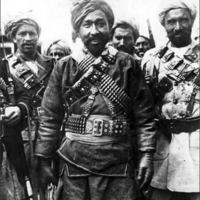Browse Exhibits (5 total)
The Rise of Islamic Insurgency (Teaching module)

This teaching module examines the case of the Basmachi movement as Islamic insurgency in Central Asia in the 1920s. Using the primary source materials from the RPI collection, students will learn:
- What internal and external factors helped insurgency leaders to recruit local population;
- How the insurgency became a political movement;
- How inadequate government policies contribute to the rise of insurgency.
Included is a description of theoretical concepts, case analysis, and bibliograhy.
Containment of Islamic Insurgency (Teaching module)

This teaching module examines the case of the Basmachi movement as Islamic insurgency and identity-based conflict, and its containment by the government in Central Asia in the 1920s. Using the primary source materials from the RPI collection, students will learn:
- What political, economic, and social factors influenced people to join the Basmachi movement;
- What economic and social policies were effective in the containment of the mass violence;
- How the acceptance of both Soviet laws and the Sharia helped in fighting with the Islamist insurgency.
Included is a description of theoretical concepts, case analysis, and bibliograhy.
Nation Building as Identity-Based Conflict (Teaching Module)

This teaching module examines aspects of the National Delimitation Project in Soviet Central Asia in the 1920s and 1930s. Using the primary source materials from the RPI collection, students will learn:
-
How dynamics of identity-based conflict affect nation building process;
-
How memories and practices of colonial power impact relationships between groups during post-colonial period;
-
What factors lead to the rise of local nationalism during nation building project.
Included is a description of theoretical concepts, case analysis, and bibliograhy.
Dynamics of Ethnic Conflict (Teaching Module)

This teaching module examines the dynamics of identity-based conflict as presented in the following 4-C model (Comparison, Competition, Confrontation, and Counteraction) in Soviet Central Asia. Using the primary source materials from the RPI collection, students will learn:
- How specific policies contributed to the experience of relative deprivation among ethnic groups in Central Asia
- How competition for the control of resources or power contributes to ethnic tensions
- The role of the third party (Russian army, Soviet government) in the exacerbation of ethnic tensions in Central Asia?
Included is a description of theoretical concepts, case analysis, and bibliograhy.
Russia: The Counterinsurgency State
Stephen Blank is Senior Fellow at American Foreign Policy Council
February 2017
The current war in the North Caucasus, in historical perspective (along with the ongoing war in Ukraine), represent the latest in an apparently unending centuries-long set of struggles over imperial “space” in and around Russia. Therefore the study of these wars sheds new light on older practices and paradigms and vice versa. Looking backward as well as forward allows us to see what has worked and what has failed in Russian counterinsurgency (COIN). Specifically, here we intend to reveal these ongoing paradigms in Muslim areas of the USSR, e.g. Central Asia and the North Caucasus by examining those practices of the 1920s in the light of the contemporary war in Chechnya that Moscow won but also in the light of the current struggle in the North Caucasus where no resolution appears in sight.
Featured Exhibit
Nation Building as Identity-Based Conflict (Teaching Module)

This teaching module examines aspects of the National Delimitation Project in Soviet Central Asia in the 1920s and 1930s. Using...